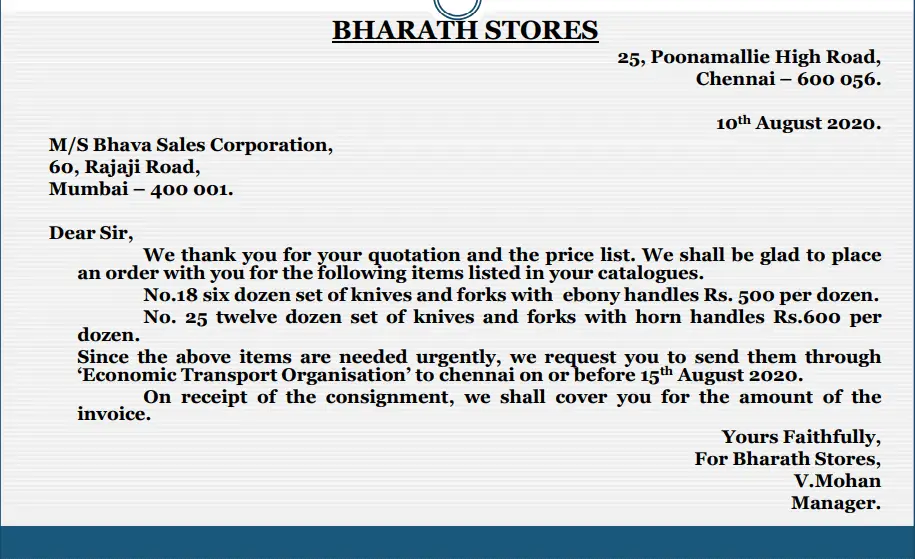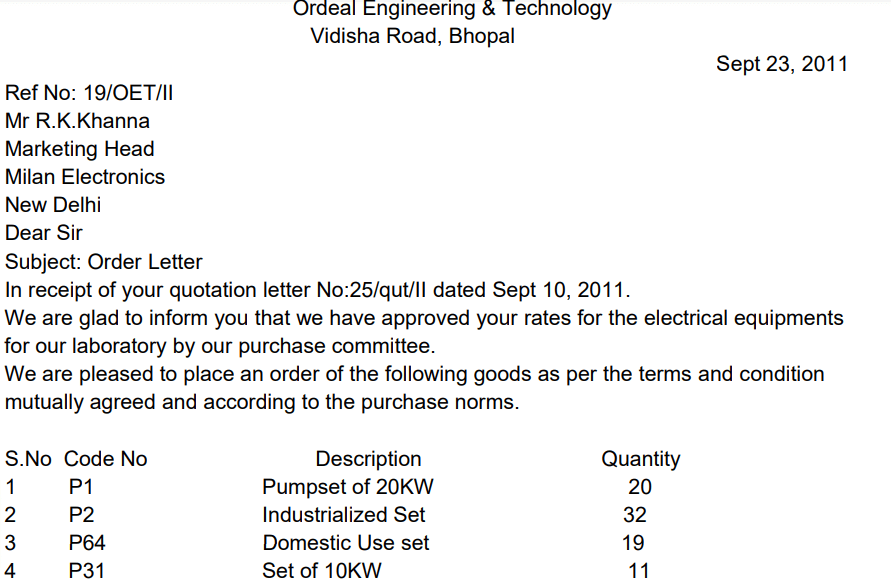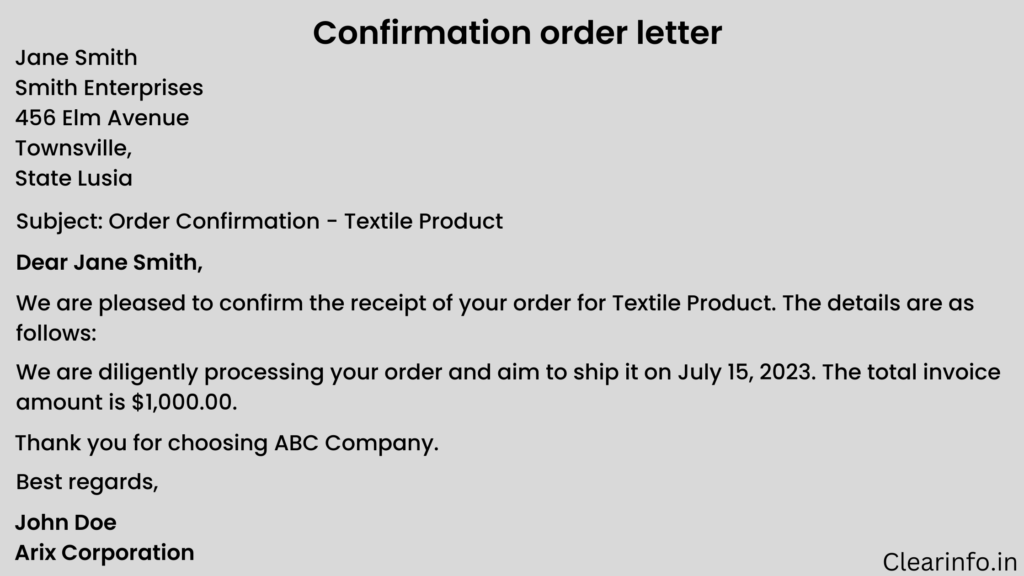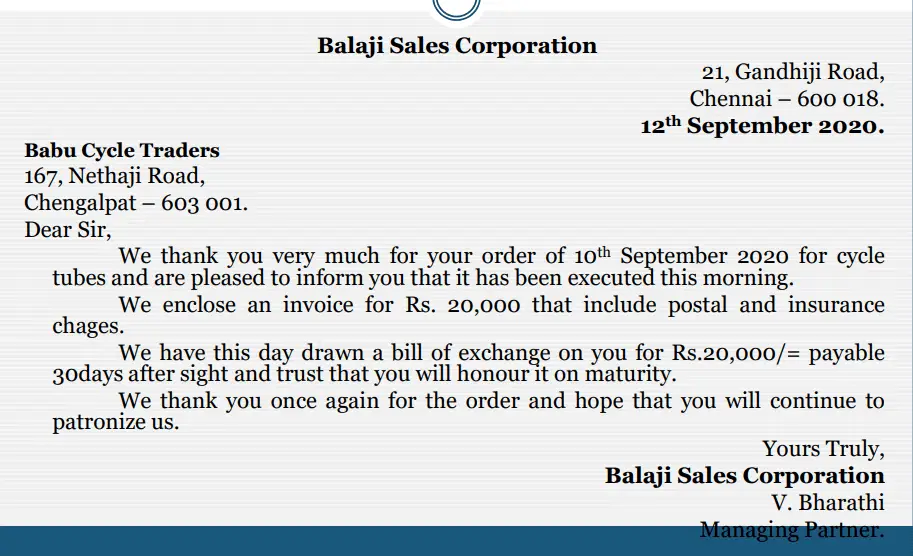Order letters are an essential part of business communication, serving as formal documents that facilitate the smooth flow of transactions. Whether it’s placing an order for goods or services, these letters play a crucial role in conveying specific details and instructions.
But what exactly is an order letter, and how does it contribute to effective communication in the business world? In this blog, we will delve into the significance of order letters, exploring their purpose, structure, and key components.
What is an order letter in business communication?
An order letter is a written communication from a buyer or customer to a supplier or vendor, expressing the desire to acquire specific goods or services. It outlines the details of the desired order, including quantity, item descriptions, price, delivery instructions, and payment terms.
Order letters play a crucial role in business transactions as they act as an official record of the transaction and help maintain a clear understanding between the buyer and the seller regarding the products or services being ordered. By specifying the desired items, quantities, and other pertinent details, order letters help minimize misunderstandings and potential errors.
Moreover, order letters also establish a formal channel of communication between the buyer and the seller. They enable the buyer to convey their requirements and expectations clearly, while also providing an opportunity for the seller to confirm the availability of the requested items, negotiate terms, and provide any necessary clarifications.
Purpose of order letter in business communication
The primary purpose of an order letter is to initiate a business transaction by providing all the necessary information for the supplier to fulfill the buyer’s request. It serves as an essential tool in business communication, facilitating the smooth process of transactions between parties involved. Order letters help streamline the ordering process, ensuring accuracy, efficiency, and ethical principles in business.
Example of Order letter

Types of Order Letters in business communication
In business communication, there are several types of order letters that are commonly used to place different types of orders. Here is a brief overview of some key types of order letters:
1/ Purchase Order Letter: A purchase order letter is one of the most common types of order letters in sales correspondence. It is used by a buyer to formally request products or services from a seller. It functions as a formal confirmation, assuring the customer that their order has been processed correctly.
2/ Cancellation of Order Letter: A cancellation of order letter is used to cancel an order that has been previously placed. It is typically sent by the customer to the seller, expressing the desire to cancel the order and providing the reasons for doing so.
3/ Order Confirmation Letter: An order confirmation letter is sent by the seller to confirm the details of an order received from a customer. It acts as an official confirmation, giving the customer reassurance that their order has been processed correctly. The letter typically includes information such as the ordered items, quantities, prices, delivery schedule, payment terms, and any other relevant details.
4/ Order Refusal Letter: An order refusal letter is sent by the seller to inform the customer that their order cannot be fulfilled. This may occur due to various reasons, such as unavailability of stock, inability to meet specific requirements, pricing or contractual disagreements, or any other valid reason.
How to write an order letter
When it comes to writing an order letter, it is important to structure it effectively and include all the necessary information. A well-written order letter should be concise and adhere to the format and elements used while writing it. By following these guidelines, you can ensure that your order letter is comprehensive and facilitates a smooth and efficient ordering process.
Order letter format in business communication
An order letter generally follows a specific structure to ensure clarity and effectiveness in communication. The format of an order letter includes:
1/ Sender’s Information: Begin the letter by including the sender’s information, such as the company name, address, contact details, and any relevant identification numbers.
2/ Date: Mention the date on which the letter is being written. This helps in maintaining a record and reference for future correspondence.
3/ Recipient’s Information: Provide the recipient’s details, including the company name, address, and any specific department or individual’s name, to ensure that the letter reaches the intended recipient.
4/ Salutation: Start the letter with a formal salutation, respectfully addressing the recipient. Use appropriate titles such as “Dear” followed by the recipient’s name or the designated position, e.g., “Dear Mr. Smith” or “Dear Sales Manager.”
5/ Body: The body of the letter contains the main content of the order. It should be clear, concise, and organized. Use paragraphs to separate different sections or points for easier readability.
The main content of the order letter includes:
1/ Order Details: Clearly specify the items being ordered, including their quantity, item description, and price per unit. This information helps the seller identify the correct products and prevents any confusion.
2/ Payment Terms: Specify the payment method, such as credit card, bank transfer, or other acceptable forms of payment. Include any relevant payment terms, such as upfront payment, installment options, or discounts for early payment.
3/ Delivery Instructions: Provide detailed instructions regarding the delivery of the ordered items, including the shipping address, preferred shipping method, and any specific handling requirements. If necessary, mention any required documents or customs information for international shipments.
4/ Special Requirements: If there are any special requests or requirements for the order, such as customization, specific packaging, or additional services, clearly communicate them in the order letter.
5/ Contact Information: Include the sender’s contact information, such as phone number and email address, for any further communication or inquiries related to the order.
By ensuring that all these key components are included and accurately provided, an order letter becomes a comprehensive document that facilitates a smooth and successful transaction between the buyer and the seller.
6/ Closing: Conclude the letter with a polite closing, such as “Sincerely,” “Regards,” or “Yours faithfully.” Choose an appropriate closing phrase based on the formality of the letter.
7/ Signature: After the closing, leave space for the sender’s signature. Include the sender’s printed name, job title, and any additional relevant contact information below the signature.
Critical elements of placing an order letter
A. Clarity and Professionalism:
- Importance of Clarity: Order letters should be written in a clear and concise manner to avoid any confusion or misinterpretation. Utilize clear and concise language to effectively convey the message.
- Professional Tone: Maintain a professional tone throughout the letter. Use formal language and appropriate business etiquette to establish credibility and foster a positive impression.
B. Concise and Specific Language:
- Specificity: Provide specific information to avoid ambiguities or misunderstandings. Clearly state the product codes, sizes, and any relevant specifications to ensure that the seller can accurately fulfill the order.
- Keep It Concise: Avoid unnecessary elaboration or lengthy paragraphs. Present the information in a concise manner, focusing on the essential details to maintain the reader’s attention and facilitate quick comprehension.
C. Accuracy and Up-to-Date Information:
- Product Information: Make sure that the information provided regarding the products or services being ordered is accurate and up-to-date. This includes product names, descriptions, models, and any specific features or options required.
- Pricing and Payment: Ensure that the prices quoted in the order letter are accurate and reflect the agreed-upon terms. Clearly state any applicable taxes, discounts, or additional charges.
- Availability: If certain items are subject to availability or potential delays, clearly communicate this information in the letter. This helps manage expectations and enables the seller to offer suitable alternatives, if necessary.
D. Contact Information:
- Follow-Up Communication: Include your contact information, such as phone number and email address, in the order letter. This allows the seller to reach you easily for any clarifications, updates, or follow-up communication.
- Inquiries and Support: Be attentive and responsive to any communication from the seller or supplier. Promptly address any questions or requests for additional information to facilitate a smooth order fulfillment process.
By incorporating these key elements into your order letter, you ensure that your communication is clear, professional, and accurate. This, in turn, minimizes the risk of misunderstandings, streamlines the ordering process, and promotes effective business relationships with suppliers or sellers.
Samples of order letters in business communication

Example of confirmation letter

Example of cancellation letter

Execution of an order
Upon receiving an order from a customer, the seller promptly proceeds to fulfill the request by dispatching the required goods according to the buyer’s instructions. To communicate the execution of the order, an execution letter is prepared, which includes the following elements:
1/ Reference to the date and number of the order: The letter begins by mentioning the specific order’s date and order number, ensuring clarity and easy reference.
2/ Expression of thanks for the order: The seller expresses gratitude to the buyer for placing the order, acknowledging the business relationship and the buyer’s trust.
3/ Intimation about the execution: The letter informs the buyer that the order is being executed and that the necessary actions are being taken to fulfill their requirements.
4/ Information about the date of dispatch and mode of transport: The seller provides details about the expected date of dispatch of the goods and the chosen mode of transportation. This ensures transparency and helps the buyer anticipate delivery.
5/ Statement of the total amount of the invoice and payment details: The letter includes a statement indicating the total amount of the invoice, along with the seller’s preferred payment method and terms.
6/ Solicitation for further orders: The seller concludes the letter by expressing interest in receiving future orders from the buyer, encouraging ongoing business collaboration.

In some cases, the seller may encounter challenges in executing the order within the specified timeframe. In such situations, the letter should be drafted carefully, considering the following points:
- Explanation of events causing delay
- Mentioning the expected resolution and revised dispatch date
- Request for understanding and patience
- Assurance of prompt attention
- Acknowledgment of the inconvenience caused
The acknowledgment of an order can indeed be classified into two further categories based on the availability of the goods:
1/ Refusal of an Order (if the goods are in stock): In some cases, despite having sufficient stock of the goods ordered, a seller may refuse to fulfill the order. This can occur due to various reasons, such as:
- Disagreement with the terms mentioned in the order, such as pricing or payment terms.
- Unresolved outstanding dues from the customer.
- The seller’s policy of selling through authorized agents only.
2/ Substitutes and Counter Offer (if the goods are out of stock): In cases where the goods ordered are currently out of stock or not produced by the manufacturer, the seller has the opportunity to consider providing substitutes or presenting a counteroffer to the customer. This approach allows the seller to suggest alternative products that can serve as replacements for the original order.
Useful tip: It’s important to note that the decision to refuse an order or offer substitutes/counteroffers should be made after careful consideration of the customer’s needs, preferences, and overall business objectives.
Importance of effective order letter in business communication
1/ Streamlining the Ordering Process and Minimizing Errors: Well-written order letters play a crucial role in streamlining the ordering process by providing clear instructions and accurate information. They serve as a reference point for both the buyer and the seller, ensuring that the order is understood correctly and executed efficiently.
2/ Establishing a Professional Image and Credibility: Order letters are a reflection of the sender’s professionalism and credibility. When order letters are well-written, they convey a sense of competence, and attention to detail. This helps the sender establish a professional image, not only in the specific transaction but also in the overall business context.
3/ Efficient Inventory Management: Well-written order letters with accurate product descriptions and quantities enable sellers to manage their inventory effectively. They provide sellers with clear information about the demand for specific products, allowing them to plan their procurement, production, and stock levels efficiently. This helps prevent stockouts or excess inventory, optimizing inventory management processes.
4/ International Trade and Customs Compliance: In the case of international transactions, order letters play a vital role in ensuring compliance with customs regulations and trade laws.
Difference between Order form vs Order letter
Order Form provides a structured and standardized approach for capturing order information, and an Order Letter offers more flexibility and allows for personalized communication. The choice between using an Order Form or an Order Letter depends on the specific requirements, preferences, and practices of the business.
Below are some common differences between an order form and an order letter:
Point of difference | Order Form | Order Letter |
Purpose | Structured document to capture order details | Formal letter to place an order |
Format | Typically pre-designed form with fields | Flexible format with standard structure |
Information | Requires filling in specific fields | Requires composing detailed content |
Layout | Organized in a tabular or sectioned format | Organized in paragraphs and sections |
Standardization | Consistent format for all orders | Content and format may vary per letter |
Completeness | Ensures all required information is provided | Relies on the writer to include all necessary details |
Usage | Commonly used for repeated or standardized orders | Used for various types of orders and may be tailored to specific needs |
Best practices for writing an order letter
Writing an effective order letter requires attention to detail and clear communication. Here are practical tips to help you craft an impactful order letter:
1/ Conduct Thorough Research: Before drafting the order letter, conduct comprehensive research on the product or service you wish to order. Ensure that it meets your requirements in terms of quality, specifications, and pricing. This research will enable you to provide accurate and specific information in your letter.
2/ Use a Clear and Readable Format: Format your order letter in a clean and easily readable manner, you can check out the format discussed in the above section. Utilize a clear and readable font, along with an appropriate font size. Separate different sections with clear headings or bullet points to enhance clarity and organization.
3/ Highlight Urgency, if Applicable: If your order is time-sensitive or requires expedited delivery, clearly indicate the urgency in the letter. Highlight specific deadlines or mention the need for swift processing and delivery. This helps the recipient prioritize your order accordingly.
4/ Include Order References: If you have any reference numbers, order codes, or specific identifiers related to the order, include them in the letter. This ensures accurate tracking and facilitates efficient processing of your request.
5/ Attach Relevant Documents: If there are any supporting documents related to your order, such as product catalogs, specifications, or reference materials, consider attaching them to the order letter. This provides additional clarity and ensures that the recipient has all the necessary information at hand.
6/ Follow Any Specific Order Guidelines: If the recipient has provided any specific guidelines or templates for placing orders, make sure to adhere to them. This shows your attention to detail and willingness to follow the recipient’s preferred format or process.
7/ Maintain a Copy for Your Records: Keep a copy of the order letter and any relevant correspondence for your own records. This helps you track the progress of the order, refer back to the details, and serve as documentation for future reference if needed.
Dos and don’t of order letter
Dos of an Order Letter:
- Be clear and concise.
- Provide accurate and complete information.
- Use a professional tone.
- Proofread and edit.
- Include contact information.
Don’ts of an Order Letter:
- Avoid vagueness or ambiguity.
- Don’t forget important order details.
- Avoid using informal language or abbreviations.
- Don’t make unreasonable demands.
- Remember to follow up.
Frequently Asked Questions
1) How do you write a letter to confirm an order?
Ans: To write a letter to confirm an order, start by expressing gratitude for the customer’s order. Clearly state the purpose of the letter and confirm the details of the order, including item descriptions, quantities, prices, delivery schedule, and payment terms. Use a professional tone and ensure the letter is clear and concise. Include your contact information for any further communication or inquiries.
2) What is an example of an order letter?
Ans: An example of an order letter is a customer placing an order with a supplier for a specific quantity of products or services. The order letter would typically include details such as the customer’s contact information, the desired items or services with their descriptions, quantities, and any specific requirements or specifications.
3) What is an order letter?
Ans: An order letter is a formal written communication sent by a buyer to a seller, or vice versa, to place a request for products or services. It serves as a clear and structured document that outlines the specific items, quantities, specifications, and terms of the order.
4) What is an order letter also called?
Ans: An order letter, also known as a purchase order letter or a sales order letter, is a written document used in business communication to formally place an order for products or services.
5) Is the order letter an informal letter
Ans: No, the order letter is not an informal letter. It is a formal business communication document used to place orders for products or services.



